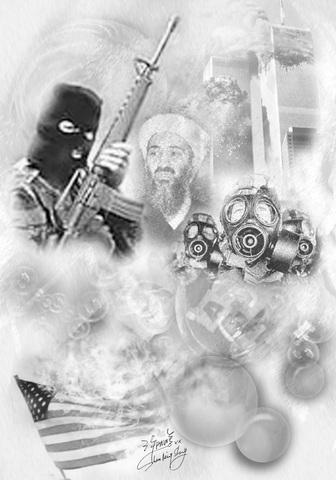Department of Homeland Security (DHS) Secretary Michael Chertoff is not getting a lot of sleep this week.
In addition to his regular duties, he is also a participant in a large-scale terrorism response exercise and has to react to simulated chemical and biological attacks.
The exercise, called Top Officials 3 (TOPOFF 3), involves 12,000 participants from three countries and is the largest such exercise ever conducted in the US. It simulates a biological attack in New Jersey and a chemical attack in Connecticut.

In addition to nearly 300 US agencies, officials from Canada and UK keep participants informed of the latest developments through a secure link.
Real newspapers and broadcasters were not given details about the simulated emergency to avoid tipping off participants.
The exercise is intended to test reactions in an environment that is as realistic as possible. To simulate a car bomb site in Connecticut, piles of rubble and cars were carefully arranged and scores of volunteers played victims.
Makeup specialists made wounds appear realistic and "victims" were given instructions on how to behave. For example, victims of the biological and chemical agents are carrying prompter cards that describe their symptoms so they know how to answer the questions of medical personnel.
"Players don't know what will happen," said DHS spokesman Marc Short.
The simulation is so realistic that some "patient" volunteers are playing the role of people who think they have the disease, and show up at medical facilities demanding treatment for symptoms they have heard on the fake news reports on VNN.
Volunteers who wanted to participate in TOPOFF 3 had to undergo a background check, Short said, to ensure that terrorist groups would not gain insight into the US response system.
Although the exercise is operating on a broad regional scale, it will not adversely impact actual emergency services or the agencies involved, said Short. That is why Chertoff, one of the high-ranking participants, will pull double duty during the exercise.
The types of attack chosen are not based on specific intelligence. Instead, Short said, the chemical and biological attacks represent events that could take place based on the capabilities officials believe terrorists have.
In all, planning and evaluation of TOPOFF 3 took two years and cost US$16 million dollars. Officials say the expenditure is worth it.
"There is no question that our coordination, precision and practice today will save countless lives tomorrow if our nations are ever again attacked by terrorists," Chertoff said.
He said that the simulation excercise offers emergency responders and top officials "a rare opportunity" to practice and validate their capabilities in response to a coordinated terrorist attack.
"It offers the chance to understand the challenges posed by biological and chemical weapons and to witness the cooperation among organizations at every level of government in protecting our homeland against the threat of terrorism," he said.
A high-school student surnamed Yang (楊) gained admissions to several prestigious medical schools recently. However, when Yang shared his “learning portfolio” on social media, he was caught exaggerating and even falsifying content, and his admissions were revoked. Now he has to take the “advanced subjects test” scheduled for next month. With his outstanding performance in the general scholastic ability test (GSAT), Yang successfully gained admissions to five prestigious medical schools. However, his university dreams have now been frustrated by the “flaws” in his learning portfolio. This is a wake-up call not only for students, but also teachers. Yang did make a big
As former president Ma Ying-jeou (馬英九) concludes his fourth visit to China since leaving office, Taiwan finds itself once again trapped in a familiar cycle of political theater. The Democratic Progressive Party (DPP) has criticized Ma’s participation in the Straits Forum as “dancing with Beijing,” while the Chinese Nationalist Party (KMT) defends it as an act of constitutional diplomacy. Both sides miss a crucial point: The real question is not whether Ma’s visit helps or hurts Taiwan — it is why Taiwan lacks a sophisticated, multi-track approach to one of the most complex geopolitical relationships in the world. The disagreement reduces Taiwan’s
Former president Ma Ying-jeou (馬英九) is visiting China, where he is addressed in a few ways, but never as a former president. On Sunday, he attended the Straits Forum in Xiamen, not as a former president of Taiwan, but as a former Chinese Nationalist Party (KMT) chairman. There, he met with Chinese People’s Political Consultative Conference Chairman Wang Huning (王滬寧). Presumably, Wang at least would have been aware that Ma had once been president, and yet he did not mention that fact, referring to him only as “Mr Ma Ying-jeou.” Perhaps the apparent oversight was not intended to convey a lack of
Chinese Nationalist Party (KMT) Chairman Eric Chu (朱立倫) last week announced that the KMT was launching “Operation Patriot” in response to an unprecedented massive campaign to recall 31 KMT legislators. However, his action has also raised questions and doubts: Are these so-called “patriots” pledging allegiance to the country or to the party? While all KMT-proposed campaigns to recall Democratic Progressive Party (DPP) lawmakers have failed, and a growing number of local KMT chapter personnel have been indicted for allegedly forging petition signatures, media reports said that at least 26 recall motions against KMT legislators have passed the second signature threshold